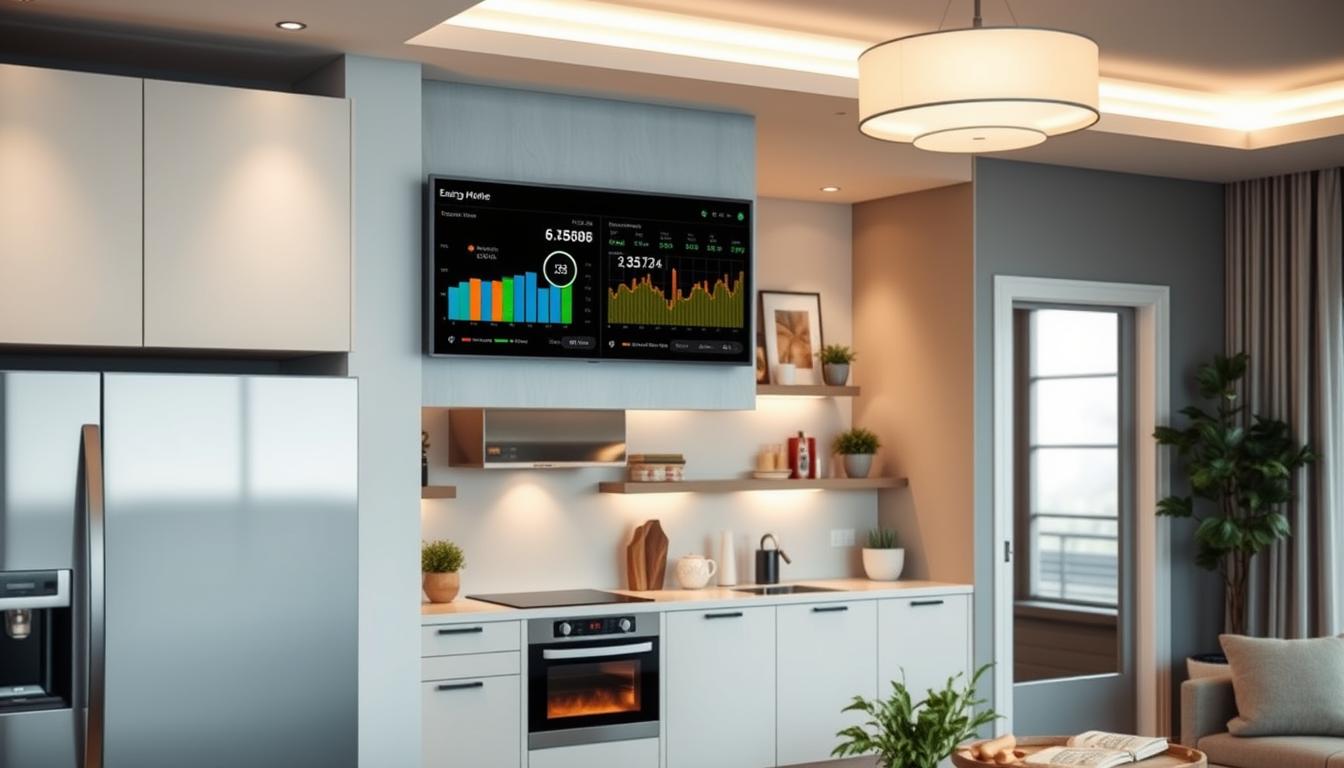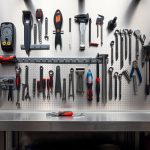As a homeowner, knowing how much power you use is key. It helps you save energy and money. Plus, it’s good for the planet. By watching your energy use, you can learn how to use less and help the environment.
Tracking your energy use shows you where you can save. You might find out that some things use a lot of power. Then, you can change to save energy. This could mean using appliances that use less power or using less energy every day.
By keeping an eye on your energy use, you can make a big difference. This guide will show you why it’s important and how to do it. You’ll learn how to use less power and help the planet.
Key Takeaways
- Understanding your power usage is crucial for reducing energy consumption and lowering energy bills.
- Energy monitoring helps identify areas of inefficiency and opportunities for improvement.
- Tracking power usage patterns can inform decisions to minimize environmental impact.
- Simple changes, like switching to energy-efficient appliances, can reduce power consumption.
- Effective energy monitoring strategies can contribute to a more sustainable future.
What is Home Power Usage Monitoring?
Home power usage monitoring tracks and manages energy use in homes. It helps understand electrical loads and usage patterns. This way, homeowners can cut down on energy waste and lower their bills.
Tracking energy is key in monitoring. It lets homeowners see how much energy they use. Electrical loads like lights and heaters use a lot of energy. By watching these, homeowners can find ways to save energy and money.
Some main benefits of monitoring include:
- Reduced energy waste
- Lower utility bills
- Improved energy efficiency
- Enhanced environmental sustainability
Knowing when you use the most energy is important. By looking at energy data, homeowners can find out when they use the most. This helps cut down on waste and bills. Monitoring is a big step towards a greener, more efficient home.
By tracking energy, homeowners can control their use and help the planet. It’s important to keep watching and adjusting to stay efficient and save energy.
| Benefits of Home Power Usage Monitoring | Description |
|---|---|
| Reduced Energy Waste | Identify areas of high energy consumption and take steps to reduce waste |
| Lower Utility Bills | Optimize energy usage to reduce energy bills |
| Improved Energy Efficiency | Enhance energy efficiency by monitoring and adjusting energy usage patterns |
Common Sources of Power Usage in Your Home
Knowing where energy is used at home is key to managing it well. Power consumption comes from many places, like appliances, lights, and heating and cooling. These areas play a big role in how much energy a home uses.
Here are some common sources of power usage:
- Refrigerators and freezers
- Clothes washers and dryers
- Air conditioning and heating systems
- Lighting, including incandescent, LED, and halogen bulbs
To cut down on power consumption, use energy-saving appliances. Turn off lights when not needed. Also, adjust your thermostat to save on heating and cooling. By knowing and tackling these energy sources, homes can better manage their energy use and lower their power bills.
Essential Tools for Tracking Power Usage
Tracking power usage is key for homeowners to cut down on energy waste. Various tools help people monitor their energy use and make smart choices. Smart meters, for example, give real-time data on how much energy is being used.
Power management gets easier with power usage monitors. These can be set up at home to track energy use. They show where energy is being wasted and offer tips to save. Energy tracking apps also let you monitor energy use from anywhere and get alerts when it’s too high.
Some important tools for tracking power usage include:
- Smart meters
- Power usage monitors
- Energy tracking apps
- Professional energy audit tools
These tools help homeowners understand their energy use better. They can make choices based on data to improve their energy efficiency.
Using these tools, people can actively track their energy use and cut it down. This not only saves energy but also helps the planet. With the right tools and knowledge, anyone can make a big difference in energy efficiency and save money too.
| Tool | Benefits |
|---|---|
| Smart Meters | Real-time energy consumption data |
| Power Usage Monitors | Identify areas of high energy consumption |
| Energy Tracking Apps | Remote monitoring and alerts |
Understanding Your Electrical Load Patterns
Knowing when you use the most energy is key to saving it. By looking at electrical loads and usage patterns, you can make smart choices about your energy use. This helps cut down on waste and lowers your bills.
It’s important to see how different things use energy. For instance, things like fridges and air conditioners use a lot. Knowing this lets you use energy better.
Here are some ways to check your energy use:
- Watch your energy use all day to find when it’s highest
- Check how efficient your appliances and devices are
- Save energy by turning off lights and gadgets when you’re not using them
By using these tips and understanding your energy use, you can manage it better. This also helps the planet.
How to Start Monitoring Your Home Power Usage
Monitoring your home’s power usage is key to managing energy and cutting waste. It helps you understand your energy habits. This way, you can spot where you can use less and make better choices about your energy use.
Setting Up Monitoring Systems
To start, you need a system to track your energy use in real-time. You can use smart meters, power monitors, or energy apps. These tools give you detailed info on how much energy you use every day, week, and month.
Creating a Baseline Assessment
After setting up your system, create a baseline of your energy use. This shows you how much energy you use now. It helps you see where you can improve and track your progress.
Tracking Methods and Best Practices
To make the most of your system, track your energy use well. Regularly check your data, look for trends, and adjust your energy use plan as needed. By doing this, you can use less energy, save money, and reduce waste.
Interpreting Power Usage Data
Understanding your energy tracking data is key to managing your power use well. By looking at your usage patterns, you can spot where you can cut down on waste. Start by reading your energy bills and understanding the graphs your supplier gives you.
When you look at your energy bills, watch for trends in your power use over time. Look for any big spikes in usage. These could mean a problem with your electrical system or a chance to use less energy. Energy tracking helps you find out which appliances and systems use the most power. This lets you focus on saving energy where it counts.
To really get into your usage patterns, try using energy tracking apps or tools. They give you detailed graphs and analysis of your power use. These tools can show you how to use less energy and save money. By keeping an eye on your energy use, you can make smart choices about how to manage it. This helps you use less energy and do better for the environment.
Identifying Consumption Patterns
- Analyze your daily and monthly energy usage to identify trends and patterns
- Look for opportunities to reduce your energy consumption during peak hours
- Consider investing in energy-efficient appliances and systems to reduce your overall power consumption
By following these steps and using energy tracking tools, you can understand your power use better. This lets you make smart choices about how to use energy. You’ll use less, waste less, and save money on your bills.
Common Power Usage Problems and Solutions
Effective power management is key to cutting down energy waste and saving energy. The first step is to spot common power usage problems. These can be anything from old, inefficient appliances to bad insulation, all affecting how much energy we use.
To fix these issues, we need to monitor our energy use. This means tracking how much energy we use, finding where it’s wasted, and fixing it. Solutions include getting new, energy-saving appliances, better insulation, and smarter lighting.
Here are some ways to use less energy:
- Do regular energy audits to find where energy is wasted
- Use smart home tech to keep an eye on and control energy use
- Switch to energy-saving appliances and lights
By using these methods, we can use less energy, save money, and help the planet. Good power management and efficiency monitoring are key to these goals.
By combining these steps, we can really cut down on energy waste. By focusing on power management and energy savings, we can all help make the world a greener place.
Smart Home Integration for Better Power Management
Homeowners are now more aware of their energy use. Smart home integration is a key solution for better power management. It uses advanced technologies to optimize energy use, reduce waste, and lower bills.
Effective power management is key to these goals. It involves using energy tracking and efficiency monitoring tools. These tools help find areas for improvement.
Smart home devices can be part of a comprehensive energy management system. This system lets homeowners monitor and control energy use from anywhere. Home energy management systems provide real-time data and insights into efficiency.
Automation solutions can also be used. They adjust energy use based on occupancy, time of day, and other factors. This leads to better power management.
Benefits of Smart Home Integration
- Enhanced energy tracking and efficiency monitoring capabilities
- Remote monitoring and control of energy usage
- Automated energy management through smart devices
- Personalized recommendations for energy efficiency improvements
By embracing smart home integration, homeowners can significantly improve power management. This leads to less energy waste. As technology evolves, we’ll see more innovative solutions for tracking and monitoring energy. This will lead to a more sustainable and energy-efficient future.
Cost Savings Through Effective Power Usage Monitoring
Monitoring power usage can save a lot of money and cut down on energy use. Homeowners can spot where energy is being wasted and fix it. This leads to lower bills and helps the planet.
Here are some ways to cut down on energy waste:
- Do regular energy audits to find where things are not working right
- Get new, energy-saving appliances and lights
- Change your daily habits to use less energy
Using these tips can really help save energy and money. Keeping an eye on how efficient things are is important. It helps make sure you’re getting the best results.
Being active about how much energy you use can pay off. You’ll save money on bills and help the environment. It’s a win-win for everyone.
| Strategy | Benefits |
|---|---|
| Conducting regular energy audits | Identifying areas of inefficiency, reducing energy waste |
| Upgrading to energy-efficient appliances | Lowering utility bills, reducing power consumption |
| Adjusting daily habits | Reducing energy consumption, achieving energy savings |
Conclusion: Empowering Your Home Energy Future
Starting your journey to monitor your home’s power usage opens doors to big savings and a greener lifestyle. By tracking your energy use, you can spot ways to use less and save more. This helps you make smart choices about how you use energy.
Tracking your power usage lets you take charge of your home’s energy future. With the right tools, you can find and fix energy-wasting spots. This not only saves you money but also helps the planet.
Let energy monitoring lead you to a future where your home uses energy wisely and saves you money. Begin today and make your home more efficient. This will make your living space better for you and your family.


